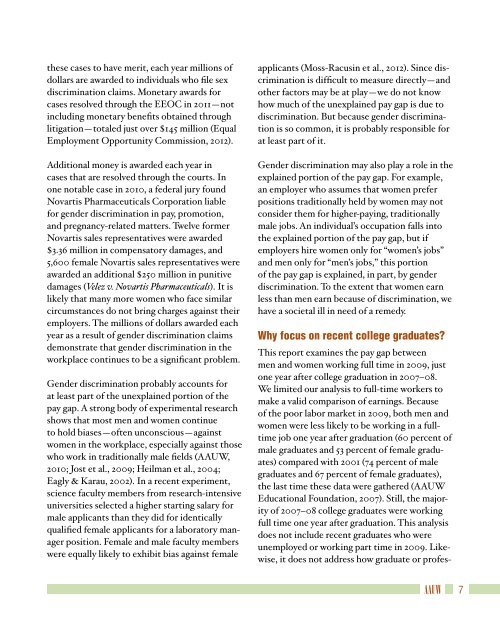graduating-to-a-pay-gap-the-earnings-of-women-and-men-one-year-after-college-graduation.pdf?_ga=1.140843954.1054147744
graduating-to-a-pay-gap-the-earnings-of-women-and-men-one-year-after-college-graduation.pdf?_ga=1.140843954.1054147744
graduating-to-a-pay-gap-the-earnings-of-women-and-men-one-year-after-college-graduation.pdf?_ga=1.140843954.1054147744
- No tags were found...
Create successful ePaper yourself
Turn your PDF publications into a flip-book with our unique Google optimized e-Paper software.
<strong>the</strong>se cases <strong>to</strong> have merit, each <strong>year</strong> millions <strong>of</strong>dollars are awarded <strong>to</strong> individuals who file sexdiscrimination claims. M<strong>one</strong>tary awards forcases resolved through <strong>the</strong> EEOC in 2011—notincluding m<strong>one</strong>tary benefits obtained throughlitigation—<strong>to</strong>taled just over $145 million (EqualEmploy<strong>men</strong>t Opportunity Commission, 2012).Additional m<strong>one</strong>y is awarded each <strong>year</strong> incases that are resolved through <strong>the</strong> courts. In<strong>one</strong> notable case in 2010, a federal jury foundNovartis Pharmaceuticals Corporation liablefor gender discrimination in <strong>pay</strong>, promotion,<strong>and</strong> pregnancy-related matters. Twelve formerNovartis sales representatives were awarded$3.36 million in compensa<strong>to</strong>ry damages, <strong>and</strong>5,600 female Novartis sales representatives wereawarded an additional $250 million in punitivedamages (Velez v. Novartis Pharmaceuticals). It islikely that many more <strong>wo<strong>men</strong></strong> who face similarcircumstances do not bring charges against <strong>the</strong>iremployers. The millions <strong>of</strong> dollars awarded each<strong>year</strong> as a result <strong>of</strong> gender discrimination claimsdemonstrate that gender discrimination in <strong>the</strong>workplace continues <strong>to</strong> be a significant problem.Gender discrimination probably accounts forat least part <strong>of</strong> <strong>the</strong> unexplained portion <strong>of</strong> <strong>the</strong><strong>pay</strong> <strong>gap</strong>. A strong body <strong>of</strong> experi<strong>men</strong>tal researchshows that most <strong>men</strong> <strong>and</strong> <strong>wo<strong>men</strong></strong> continue<strong>to</strong> hold biases—<strong>of</strong>ten unconscious—against<strong>wo<strong>men</strong></strong> in <strong>the</strong> workplace, especially against thosewho work in traditionally male fields (AAUW,2010; Jost et al., 2009; Heilman et al., 2004;Eagly & Karau, 2002). In a recent experi<strong>men</strong>t,science faculty members from research-intensiveuniversities selected a higher starting salary formale applicants than <strong>the</strong>y did for identicallyqualified female applicants for a labora<strong>to</strong>ry managerposition. Female <strong>and</strong> male faculty memberswere equally likely <strong>to</strong> exhibit bias against femaleapplicants (Moss-Racusin et al., 2012). Since discriminationis difficult <strong>to</strong> measure directly—<strong>and</strong>o<strong>the</strong>r fac<strong>to</strong>rs may be at play—we do not knowhow much <strong>of</strong> <strong>the</strong> unexplained <strong>pay</strong> <strong>gap</strong> is due <strong>to</strong>discrimination. But because gender discriminationis so common, it is probably responsible forat least part <strong>of</strong> it.Gender discrimination may also play a role in <strong>the</strong>explained portion <strong>of</strong> <strong>the</strong> <strong>pay</strong> <strong>gap</strong>. For example,an employer who assumes that <strong>wo<strong>men</strong></strong> preferpositions traditionally held by <strong>wo<strong>men</strong></strong> may notconsider <strong>the</strong>m for higher-<strong>pay</strong>ing, traditionallymale jobs. An individual’s occupation falls in<strong>to</strong><strong>the</strong> explained portion <strong>of</strong> <strong>the</strong> <strong>pay</strong> <strong>gap</strong>, but ifemployers hire <strong>wo<strong>men</strong></strong> only for “<strong>wo<strong>men</strong></strong>’s jobs”<strong>and</strong> <strong>men</strong> only for “<strong>men</strong>’s jobs,” this portion<strong>of</strong> <strong>the</strong> <strong>pay</strong> <strong>gap</strong> is explained, in part, by genderdiscrimination. To <strong>the</strong> extent that <strong>wo<strong>men</strong></strong> earnless than <strong>men</strong> earn because <strong>of</strong> discrimination, wehave a societal ill in need <strong>of</strong> a remedy.Why focus on recent <strong>college</strong> graduates?This report examines <strong>the</strong> <strong>pay</strong> <strong>gap</strong> between<strong>men</strong> <strong>and</strong> <strong>wo<strong>men</strong></strong> working full time in 2009, jus<strong>to</strong>ne <strong>year</strong> <strong>after</strong> <strong>college</strong> <strong>graduation</strong> in 2007–08.We limited our analysis <strong>to</strong> full-time workers <strong>to</strong>make a valid comparison <strong>of</strong> <strong>earnings</strong>. Because<strong>of</strong> <strong>the</strong> poor labor market in 2009, both <strong>men</strong> <strong>and</strong><strong>wo<strong>men</strong></strong> were less likely <strong>to</strong> be working in a fulltimejob <strong>one</strong> <strong>year</strong> <strong>after</strong> <strong>graduation</strong> (60 percent <strong>of</strong>male graduates <strong>and</strong> 53 percent <strong>of</strong> female graduates)compared with 2001 (74 percent <strong>of</strong> malegraduates <strong>and</strong> 67 percent <strong>of</strong> female graduates),<strong>the</strong> last time <strong>the</strong>se data were ga<strong>the</strong>red (AAUWEducational Foundation, 2007). Still, <strong>the</strong> majority<strong>of</strong> 2007–08 <strong>college</strong> graduates were workingfull time <strong>one</strong> <strong>year</strong> <strong>after</strong> <strong>graduation</strong>. This analysisdoes not include recent graduates who wereunemployed or working part time in 2009. Likewise,it does not address how graduate or pr<strong>of</strong>es-AAUW7


